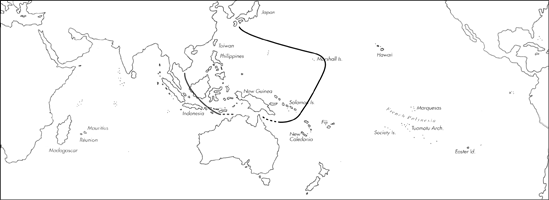
Skip Navigation Links
View access keys for this site.

Range: Japan to Marshall Is. and to Indonesia, Papua New Guinea and Solomon Is.; probably also Fiji.
Description: Medium-sized to moderately large, moderately solid to solid. Last whorl usually conoid-cylindrical to nearly cylindrical or slightly ovate, outline slightly convex. Siphonal fasciole prominent. Shoulder sharply angulate. Spire of low to moderate height, outline straight to slightly convex. Larval shell multispiral, maximum diameter about 0.6 mm. First 3 postnuclear whorls weakly tuberculate. Teleoconch sutural ramps flat in early whorls, concave in late whorls, with 2 increasing to 3-4 spiral grooves. Last whorl with regularly spaced, broad spiral ribs, distinct basally but obsolete adapically.
| Shell Morphometry | ||
|---|---|---|
| L | 40-64 mm | |
| RW | 0.21-0.35 g/mm | |
| (L 40-56 mm) | ||
| RD | 0.48-0.63 | |
| PMD | 0.71-0.78 | |
| RSH | 0.07-0.18 | |
Ground colour white to pale grey. Last whorl with spiral rows of irregularly alternating blackish brown dots and white dashes or bars. Dark dots clustered into patches forming 2 interrupted spiral bands of both sides of centre. Larval whorls pink. Teleoconch sutural ramps with blackish brown markings along inner and outer margins, partially connected across the ramps. Aperture orange deep within.
Periostracum yellowish olive, thin, translucent, velvety smooth.
Dorsum of foot with a large crown-shaped black zone anteriorly, separated from light brown anterior edge by 2 lateral white blotches; marginal zone cream with radiating black markings, densely clustered at posterior end; median zone white, mottled with black and brown and edged with a black line. Sole of foot white, mottled or transversely streaked with brown. Rostrum cream at tip, streaked with dark brown proximally. Tentacles white with black tips. Siphon white, mottled with light brown dorsally posterior to the tip and with darker brown proximally (Pl. 74, Fig. 24; Pl. 78, Fourth row, right) (Chaberman, pers. comm., 1981 ; de Couet, pers. comm., 1992).
Radular teeth with a large pointed adapical barb, a large second barb, and a long backward-pointing third barb terminating in a recurved tip: neither serration nor basal spur present (Endean & Rudkin, 1965).
Habitat and Habits: Intertidal and uppermost subtidal; in sand and beneath corals. C.stercusmuscarum probably preys on fishes (Endean & Rudkin, 1965). Egg diameter of 235-240 ┬Ám predicts a minimum pelagic period of about 20 days (Perron & Kohn, 1985).
Discussion: C.stercusmuscarum is very similar to C. arenatus in colour pattern but differs markedly in its conoid-cylindrical to ovate and generally narrower last whorl, non-tuberculate late teleoconch whorls. and pink larval shell. The differences in feeding habits, radular tooth structure, and body colouration also distinguish these species.

C. stercusmuscarum Range Map
This section contains verbatim reproductions of the accounts of 316 species of Conus from the Indo-Pacific region, from Manual of the Living Conidae, by R÷ckel, Korn and Kohn (1995). They are reproduced with the kind permission of the present publisher, Conchbooks.
All plates and figures referred to in the text are also in R÷ckel, Korn & Kohn, 1995. Manual of the Living Conidae Vol. 1: Indo-Pacific Region.
The range maps have been modified so that each species account has it own map, rather than one map that showed the ranges of several species in the original work. This was necessary because each species account is on a separate page on the website and not confined to the order of accounts in the book.
Return to framed version (returns to search page)